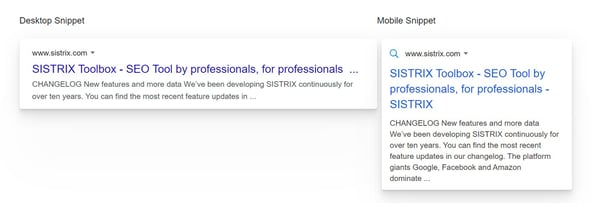
Aslan Kudrnofsky
What's the ideal Meta Description for a Blog Post?
A meta description is an important SEO factor. Like a movie trailer, it should encourage readers to click on your blog post. Learn how to achieve that in this article.
Do you like watching movies? Then you're already quite familiar with the purpose of a meta description for blog posts. It's very similar to a good trailer, with which filmmakers want to excite the audience and lure them in front of the screen. Very briefly, some scenes are shown that tease the content of the film as well as its highlights. You learn from awards, press reviews and the like that the film is really worth seeing and at the end you are invited to watch it. The more viewers decide to see the film afterwards, the more successful the trailer was. The same goes for the meta description of your blog post and any other website or landing page.
Internet users should be able to decide whether to open the respective page on the basis of a short text excerpt in the search results of search engines and social media platforms. These so-called SERP snippets consist of a meta title and a meta description, i.e. a short descriptive text that is stored in the head area of the corresponding HTML document. Technically, this part of content creation is not that difficult, yet very important. To understand this and create ideal meta descriptions for blog posts from now on, feel free to read on.
Expert Advice:
When optimizing your blog post for Google, the first step is to follow Google's instructions. At Google Search Central (formerly Google Webmaster) you can find aspects of SEO for meta descriptions relevant for Google.
What is a Meta Description?
The meta description (also "SEO Description" or "Meta Description Tag") is a short content summary, including a call to action. It is displayed alongside the meta title as SERP snippet (or Google snippet) in the search results and should be written manually for each accessible page of your online presence and stored in the HTML source code. Nowadays, almost all professional CMS (Content Management Systems) offer an integrated function to create a meta description without having to work in the source code. In addition, plugins are usually available, such as for WordPress. If the meta description is missing, Google and other search engines will display a self-compiled description that best fits the user's search query.

Why are Meta Descriptions important for Blog Posts?
You may be wondering why the meta description is important at all. This question is reasonable, because where the meta description is missing, Google itself simply adds a text excerpt that fits the search query of the Internet user. So the description never stays empty. Moreover, only very few people go to page 2 or 3 of the search results. According to a Sistrix study on Google CTR, it's less than 1% of users. Therefore, your specially written meta description will presumably not encourage anyone to click on it as long as it is not at least among the top 10 search results and is read at all. Nevertheless, professional SEO tools like ahrefs count a missing meta description as one of the serious errors of a page, which are displayed in alarming red.
So why are meta descriptions so important for blog posts and other pages?
- Because the click-through rate affects your ranking
Although meta descriptions aren't a direct ranking factor with search engines, they do have an impact on the Click-Through Rate (CTR) of the page. SEO specialists assume that pages with a higher click-through rate will rank higher. So, the goal is to encourage potential readers to click on your blog post. - Because you would miss an opportunity
While Google does create a snippet itself if the meta description is missing or not very suitable for the search query, you would miss an important opportunity to make Internet users want to read your blog post. A successful description generates curiosity, promises to solve a problem or provide valuable information. Don't miss this chance.
Expert Advice:
It makes little sense to continuously optimize your snippet until your blog post has made it into the Top 10 on Google. Just try to write an attractive meta description for your blog post from the beginning and review it as soon as you are among the highest ranked.
What should you pay attention to in the meta description?
When creating an ideal meta description, you should keep a few things in mind:
- Pay attention to the length of the meta description
Technically, the length of a meta description is measured in pixels. For desktops, this is currently 990px and for mobile devices 1,300px including spaces. - Rich snippets reduce character length
Rich snippets are special elements such as the date or author that can shorten the character length of a meta description. - Use emojis and special characters intentionally
In general, you can use all special characters and emojis. However, use them consciously, because they should fit into your overall online presence and fulfill a purpose. - Create unique Meta Descriptions
Each blog post should be unique to avoid being classified as Duplicate Content by Google. - Use the main keyword of your Blog Post
The main keyword (or "focus keyword") should be included in the meta description, otherwise Google will create a description itself.
Expert Advice:
Online, you'll read over and over again that the meta title and meta description should not be cut off. If this causes comprehension problems, we agree. However, if the content is easy to understand and still arouses the curiosity of the Internet user, there's no issue.
How to create the ideal Meta Description
A very popular method in content marketing is the AIDA model. According to this model, it is not a problem if the title is not displayed in full. Apart from the fact that at least Google changes the length of the SERP snippets every now and then, curiosity is created here as to what exactly is hidden behind the 3 dots.
The AIDA Model
On the one hand, the AIDA model corresponds to Google's requirement for a clearly structured description: "Add clearly structured data to the description. (see Google Search Central: Meaningful Titles & Snippets). On the other hand, this model attracts the attention of readers, arouses their interest as well as a certain desire to finally encourage them to open your blog post.
- A = Attraction
The reader's attention is caught here by a question. - I = Interest
A specific interest of the reader is addressed, which in this case are tools for good blog posts. - D = Desire
A desire is created in the reader for what the blog post promises. In our example, it is the desire to write good blog posts for readers and search engines. The special character ▷ indicates the optimal result. - A = Action
The reader is encouraged to click, i.e. to open the blog post by the → arrow as well as the CTA (Call-to-Action) "Learn more now".
Special Characters in a Meta Description
Special characters such as check marks, arrows or emojis emphasize the structure of the meta description and additionally attract the attention of users. Content marketers like to use the following characters:
| ✓ | the statement is correct / true / comprehensible |
| ▷ | reference / proof to support the statement |
| ✚ | multiple advantages / aspects / consequences |
| ✘ | these effects / things can be avoided |
| ★ | special product / service / konwledge etc. |
| ♥ | review or favorite product / service |
| ☎ | contact |
| ➨ | CTA (Call-to-Action) |
Structure and Text of a Meta Description for Blog Posts
As you've already seen, the AIDA model is a successful technique to encourage readers to click on your blog post. In addition, you can also use the meta description to strengthen your brand and create more recognition value. This way, you will appeal to Internet users who are very interested in your industry and who use search engines to gather information.
There are two things you can do to achieve this uniqueness:
- The structure of your Meta Description
Give your descriptions a unique twist that keeps recurring, such as using the same brand tagline over and over or an emoji that matches your content. - The Text of your Meta Description
Your own style is distinctive, whether you write a long text or a short text excerpt. So let your own style shine through in your descriptions, e.g. through witty phrasing or a frequent use of adjectives.
Best-Practice Examples of ideal Meta Descriptions
Ultimately, there are many different ways to write an ideal meta description. As a little inspiration, here are some successful best-practice examples:



Meta Description Tool: SERP-Snippet Generator
A fantastic tool that we at Contentfish wouldn't want to miss is the free SERP snippet generator by Sistrix or Seobility. Here, you simply enter your title and meta description to get a preview of your SERP snippet. It also takes care of special characters that you can add from a list. To be absolutely sure that your focus keyword is placed wisely, enter it in the provided field to check it in the preview.
We used SERP snippet generator for this blog post as well. The result shows that the meta description would be separated on a desktop by adding the rich snippets.

Conclusion
Think back to the movie trailer. It is the first touch point- unique, short and to the point. In a way, it makes the audience curious about the movie and invites them to watch it via a Call-to-Action. For example, if you're a fan of Tarantino films, you'll already recognize this great film producer by the trailer. Your meta description for blog posts should be just as recognizable and appealing. Use this SEO factor to convince search engines and readers of your content early on.
Let's talk about Content
Arrange a consultation appointment without any obligations.
Book a free Meeting